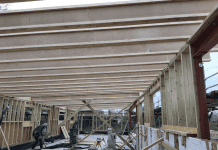The application of Building Information Modelling (BIM) within the historic environment is a developing concept that could potentially transform the way we understand and preserve structures
To support this emerging sector, the BIM4Heritage group has been created to provide a forum to share knowledge and lessons learnt on the application of BIM for heritage. Supported by a wide range of heritage groups, contractors and consultants amongst others, BIM4Heritage held its official launch conference on the 14 September, in the Royal Academy of Arts Burlington House.
Established within the BIM4Communities, the group champions BIM within the Historic Environment. Membership is open to all interested parties and current members include those from within the AEC industry, Conservation, Heritage Organisations Academic Departments and end-users. The intention of the BIM4Heritage Group is to provide a forum for organisations and industry professionals to share knowledge and lessons learnt on BIM applied to historic structures.
BIM4Heritage member organisations:
The launch conference, sponsored by Lendlease and the Royal Academy of Arts, was hosted by Edonis Jesus, BIM Leader at Lendlease and founder of BIM4Heritage and Steve Watson, Head of Engineering for the Royal Academy of Arts.
The group organised a range of presentations for its launch event with the goal to promote the learning awareness and understanding of BIM implementation within the Historic environment.
Edonis Jesus said: “I am delighted with the great success of the BIM4Heritage launch conference! BIM technologies and processes bring so many benefits to conservation, restoration, rehabilitation, repair and maintenance activities and it was great to share lessons learnt and knowledge with the wider industry and to see the great interest in our initiative.”
Edonis Jesus opened the conference speaking about the concepts of BIM, BIM Level 2 and the benefits of BIM for the Historic Environment.
Ingval Maxwell OBE (COTAC, Chair) discussed the need for conservation charters, principles, standards and philosophies and ethics to be considered in balance with new- build orientated BIM initiatives.
Paul Bryan (Historic England, Geospatial Imaging Manager) officially launched Historic England’s latest guidance publication on ‘BIM for Heritage’, offering direction for building owners, end-users, heritage and construction professionals on potential advantages of BIM approaches across heritage projects.
Steve Watson (Royal Academy of Arts, Head of Engineering) spoke about the RA’s journey to date on implementing and using BIM on its masterplan development.
Carl Brooks (Ramboll, Director) presented the Harmondsworth Barn and Kings Cross lighthouse building, looking at the process of combining existing asset information captured with point clouds and hybrid approaches on interfaces between old and new.
Marianne Partyka (Page Park Architect and Head of BIM) demonstrated how BIM is being applied on the restoration of the Mackintosh building at the Glasgow School of Art.
Vajira Premadasa (Historic Environment Scotland, Architect) presented the Edinburgh Castle case study, outlining challenges and opportunities of implementing BIM and discussed HSE’s wider BIM Strategy.
Finally, Ann Kemp (UK BIM Alliance, Chair) closed the event by discussing BIM in the UK and the projects being led by the UK BIM Alliance.
A full report on the conference will be published soon on the BIM4Heritage website (www.bim4heritage.org)

















